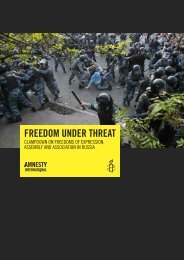From McLibel to e-Libel (correction) - Recurring problems in Defamation Law
From McLibel to e-Libel (correction) - Recurring problems in Defamation Law
From McLibel to e-Libel (correction) - Recurring problems in Defamation Law
You also want an ePaper? Increase the reach of your titles
YUMPU automatically turns print PDFs into web optimized ePapers that Google loves.
Is the cap work<strong>in</strong>g?<br />
The <strong>in</strong>troduction of the cap on damages and the requirement that judges and not juries<br />
determ<strong>in</strong>e damages were designed <strong>to</strong> put an end <strong>to</strong> large damages award. However, as John-<br />
Paul Cashen po<strong>in</strong>ts out <strong>in</strong> his article “<strong>Defamation</strong> Cap Ris<strong>in</strong>g Well Above Inflation” (Gazette<br />
of <strong>Law</strong> and Journalism, 10 December 2014), and as the table set out above shows, damages<br />
are gett<strong>in</strong>g higher, rather than lower, and awards of a nom<strong>in</strong>al sum are rare <strong>in</strong>deed.<br />
Is it a cap or a ceil<strong>in</strong>g? Op<strong>in</strong>ions differ. In Attrill v Christie [2007] NSWSC 1386 at [44], Bell<br />
J considered the cap was the “outer limit” on damages (see also Visscher v Maritime Union of<br />
Australia (No 6) [2014] NSWSC 350 at [235]). One of the damages developments <strong>in</strong> 2014<br />
was Kyrou J’s rejection of Bell J’s reason<strong>in</strong>g <strong>in</strong> Cripps v Vakras [2014] VSC 279 at [599] –<br />
[608], on the basis that it followed the pre-uniform legislative <strong>in</strong>terpretation of s 46A<br />
<strong>Defamation</strong> Act 1974 (NSW).<br />
Are other awards a guide? This was not the case under the repealed legislation; see the<br />
comments of Young J <strong>in</strong> John Fairfax Publications Pty Ltd v O'Shane (No 2) [2005]<br />
NSWCA 291 where his Honour doubted whether consideration of comparable verdicts<br />
should be permissible under s 46A <strong>Defamation</strong> Act 1974 (NSW). That is not the approach<br />
taken by the Queensland Court of Appeal <strong>in</strong> relation <strong>to</strong> the uniform legislation: Cerutti v<br />
Crestside Pty Ltd [2014] QCA 33. As is set out <strong>in</strong> more detail below, other courts have taken<br />
a different view.<br />
The method of calculation of damages<br />
It is now clear from the emerg<strong>in</strong>g patterns of assessment of damages that there are significant<br />
differences <strong>in</strong> the manner of approach of assessment of damages be<strong>in</strong>g taken by judges.<br />
These differences have not been the subject of comment by the New South Wales Court of<br />
Appeal; <strong>in</strong> Clarke v Coles Supermarkets Australia Pty Ltd [2013] NSWCA 272 the Court of<br />
Appeal dismissed the damages appeal <strong>in</strong> one sentence, on the basis that no issue of pr<strong>in</strong>ciple<br />
was raised (at [103]). The nature and extent of these differences can best be exam<strong>in</strong>ed by<br />
careful comparison of two publications where a jury found certa<strong>in</strong> of the imputations<br />
conveyed were true but the pla<strong>in</strong>tiff succeeded overall: Cerutti v Crestside Pty Ltd [2014]<br />
QCA 33 and Fisher v Channel Seven Sydney Pty Ltd (No 4) [2014] NSWSC 1616.<br />
Cerutti v Crestside Pty Ltd [2014] QCA 33<br />
The defendant sent a letter of compla<strong>in</strong>t about the services of an accountant <strong>to</strong> the CPA<br />
Australia (the govern<strong>in</strong>g body for certified public accountants), the Pioneer Permanent<br />
Build<strong>in</strong>g Society and the Australian Institute of Company Direc<strong>to</strong>rs. The imputations were<br />
that the pla<strong>in</strong>tiffs (an accountant and his company) had:<br />
(a) misled Mr Turnour <strong>in</strong> relation <strong>to</strong> the circumstances under which Mr Scagliotti’s<br />
employment ceased;<br />
(b) had issued <strong>in</strong>voices <strong>in</strong>tend<strong>in</strong>g <strong>to</strong> deceive Mr Turnour;<br />
(c) had issued an <strong>in</strong>voice <strong>in</strong>tended <strong>to</strong> disguise an “excessive” fee for Yasm<strong>in</strong>;<br />
(d) had engaged <strong>in</strong> “dishonest” practices when issu<strong>in</strong>g accounts;<br />
(e) engaged <strong>in</strong> “unfair practices” when issu<strong>in</strong>g accounts; and<br />
(f) were unethical.<br />
20



